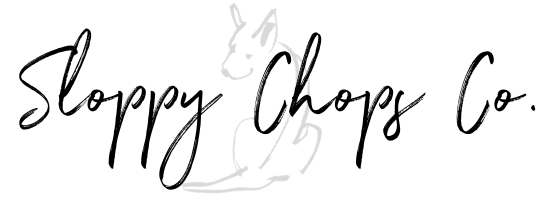General Leather Information
Selecting your leather is more than just choosing a color. We have spent what most would consider an inordinate amount of time testing different leather types from various tanneries over the years. Every leather type will feel different in hand, have different characteristics and age differently than the other. We would love to share some of this information with you so you can make the best choice possible for you and your pet's lifestyle.
GENERAL LEATHER INFORMATION:
Sloppy Chops Co. only uses full-grain leather for our collars and leashes. Full grain refers to a hide whose top layer (the strongest part of the hide) has not been altered. Other types of leather are top grain (the top layer/strongest part of the hide has been sanded down), corrected grain, and and genuine leather (usually the scrap bits).
The leather we use is drum dyed, meaning the color is infused during the tanning process and not hand-dyed in our shop. We prefer drum dyed leather because it is less apt to bleed than hand-dyed leather -- however, it is important to note that all leather, regardless of the tannery and finishing process, can bleed color unless it is left in its natural, undyed state. Bleeding of color is usually not a concern nor noticeable aside from on lighter-colored dogs and/or when it gets wet. Personally, we have not experienced bleeding of colors on any of our testers, but just know it is not unexpected if it does occur.
Leather comes in different weights and grades. The higher the weight, the thicker the leather. The weight of the leather we offer varies and will be listed in Our Leather section.
Being a natural material, each hide of leather is unique and will possess different characteristics and natural markings, even if it is from the same manufacturer and created via the same tanning process. Therefore, variances in the uniformity of the material is a natural expression of leather's unique character and should be anticipated.
We offer three different types of leather in the shop: Latigo, Vegetable Tanned, English Bridle (yes, technically English Bridle is vegetable tanned, but don't worry, we will elaborate on why below).
VEGETABLE TANNED
Vegetable tanning refers to the use of tree-based tannins in the tanning process. The vegetable tanning process takes one to three months to complete vs. one to three days needed for chrome tanning. Due to the longer production time, it is a more expensive leather compared to chrome-tanned leathers. While veg tanning is accepted to be more ecological than chrome tanning, we cannot with integrity assert any tanning/manufacturing process as wholly 'environmentally friendly'.
Veg tanning encompasses a very broad arena, as there are many different ways to veg tan a hide that will yield different finished results. In fact, English Bridle leather (see below) is a type of veg tanned leather. We cannot cover all of the different aspects, but in general, veg tanned leather is viewed as a more "artisan" leather. We have opted to put it into its own category separate from the Latigo and English Bridle because, after much trial and error, we have found a particular tannery of which we have become very fond. When we refer to “veg tanned” leather for our products, know that we will be referring -- quite specifically -- to the stock we carry from this tannery (see photo above). This tannery 'hot stuffs' their veg tanned leather, meaning it is infused with oils and fats to increase its durability. Its oil/fat content is technically not as high as English Bridle or Latigo, but we have found it to be a superior leather for abrasion resistance and overall character.
Due to this leather being hot stuffed, it can handle freshwater exposure for shorter periods with proper aftercare. For the sake of longevity of the product, I wouldn't recommend it being submerged for longer periods or regular water exposure -- Biothane is recommended for such activities for its peace of mind.
ENGLISH BRIDLE
English bridle leather is a type of vegetable tanned leather that is then hot-stuffed with oils and waxes. English Bridle is smooth, flexible yet durable. Beautifully crafted with an even surface, the grain-side finish on English Bridle is usually more uniform in appearance and generally doesn’t show as many characteristics of the hide as other types of leather. However, being that it does have a more refined finish, scratches that occur with wear can seem more apparent than with other leather options.
LATIGO
Latigo leather is combination-tanned, meaning first it’s chrome-tanned and then vegetable-tanned. The leather is then hot-stuffed with a good amount of waxes and oils, making it quite durable. It’s a lengthy process and drives up cost, making it one of the most expensive types of cow hide leather. Because of the chrome tanning process involved, it is also worth noting that Latigo leather is not considered as environmentally friendly as strictly vegetable tanned leather.
Due to the increased amount of waxes and oils used on the leather, Latigo does better with water exposure than most other types of leathers; for this reason it’s pretty popular amongst dogs and horses. You might see some people saying their dogs “swim and dock dive in their leather collars and they’ve held up great!”. This is very likely Latigo leather. With that being said, we still advocate for minimizing regular and prolonged water exposure to give your gear the greatest natural life. For consistent or prolonged water exposure (especially salt water), we recommend our Biothane products.
